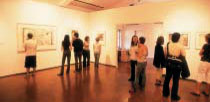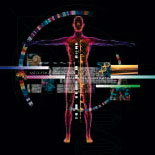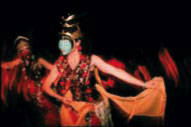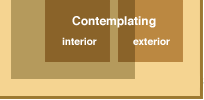| |
A flexible, adaptable space allows for artistic expression in different media. The heart of the
Center uses its open architectural plan and innovative technology to inspire visitors. It invites
us to explore, study, examine, and define visual culture. An active program of changing
exhibits inspires visitors to return. Exhibition Space
In a traditional gallery one expects to find only fine art, authoritatively defined and presented. That is not
the case here. Instead we are struck by the juxtaposition of art and that which is not traditionally seen
as art. We are surrounded by visual culture of all kinds. Photographic images from deep space sit side
by side with other artistic impressions of the heavens. The human form, as rendered by the masters, is
compared with scientific imagery, created digitally with contemporary tools. We are invited to look with
new eyes and make unexpected connections.  
In an introductory graphic we learn how the mission of the Center is expressed in the exhibitions it
presents. The Center mounts exhibitions that fall into three primary categories: Traveling Exhibitions that
are created by other institutions; Interdisciplinary Exhibitions that include collaborations between different
domains of knowledge at the University; and, Center-Sponsored Exhibitions that are created, and mounted
by Center staff, visiting artists, and curators. The following are examples of from each exhibition category:
Traveling Exhibitions:
Genomic Art: Portrait of the 21st Century
This exhibition presents the work of a variety of artists engaged in the struggle to understand and
to interpret some of the complex information of this genetic age. Featured artists include Joan
Fontcuberta, Susan Rankaitis, Inigo Manglano-Ovalle, and Helen Donis-Keller, a former molecular
biologist. In a sense, these artists are social mediators, offering interpretations and possibilities, as
they adopt and adapt some of the remarkable new techniques and technologies available to scientists
who are unraveling "the genesis of our being."
The World According to the Newest and Most Exact Observations: Mapping Art and Science
This exhibition brings together examples from five centuries of map making, combining more than
50 geographic maps and atlases with scientific objects, models, genetic sequencing equipment, and
artwork by 16 contemporary artists, includung Wim Delvoye, Ed Ruscha, and Ericson + Ziegler, who
use map imagery in their work.
Narratives of a Negress: Kara Walker
Known for her black paper cut silhouettes, Kara Walker is an artist who has quickly become one of
the most important voices of her generation. Her images depict civil war era scenes filled with visual
stereotypes, sex, violence, and disquieting power relationships. Constructing anti-racist parodies,
Walker figures within a group of African-American artists whose work addresses racial identity in a
confrontational way.

Interdisciplinary Exhibitions:
Collapsing Histories
This exhibition calls upon the disciplines of Art History, Cultural Studies, History, Philosophy, Holocaust
Studies, Sociology, and the Visual Arts using examples from across the UCSC University community
and beyond. Collapsing History addresses at least three primary topics to interpretation 1) the nature
of representation itself, 2) the nature of historicism, and 3) artistic practice and the nature of aesthetics.
Dimensions in Clay
When we look at ceramics in a traditional art gallery we generally admire color and form alone. Yet,
as one of the most durable forms of human creation, ceramic materials are used in every technical
field from space travel to computer hardware. This exhibition examines not only the beauty of ceramics
from across the globe, but also its chemical composition, its scientific applications its historical relevance, and its cultural importance.

Center-Sponsored Exhibitions:
Lines of Sight: Views of the U.S./Mexican Border
This exhibition features contemporary views of the international divide between Mexico and the United
States through the eyes of four artists based north and south of the border line: Julián Cardona in
Ciudad Juárez and Mexico City, Yvonne Venegas in Tijuana and New York City, Ricardo Duffy in Los
Angeles and Orange County, and Rubén Ortiz Torres in Los Angeles and Mexico City. Their dramatic
vision of this contested landscape offers us an important view of the differences and commonalities
between cultures and nations.
Earthsong: New Visions in Land Art Since 1970
From Robert Smithson's Spiral Getty to Andy Goldworthy's Touching North, artists have been working
with natural materials in the landscape for generations. Photography has been the primary medium
for sharing this extraordinary work with the public. Earthsong: New Visions in Land Art Since 1970
will feature photographs by artists such as Richard Long, Walter de Maria, Robert Smithson, Andy
Goldsworthy, Nancy Holt, Christo, and others who have been instrumental in taking art practice out
of the museum setting and into other environments such as the desert, the sea, and the forest. While
the exhibit is in the gallery, an artist in residence, possibly Andy Goldsworthy, will be invited to produce
a new earth work that takes advantage of the exceptional beauty of the redwoods and ocean that
frame the UCSC campus.

Throughout the Center, we see visitors interacting with images and ideas. Some are using hand-held
PDAs to access layered information about the art and objects that fill the galleries. Others are participating
in a docent-led tour. Students and faculty are engaged in discussion about how the ideas presented at
the Center illuminate their understanding of their own fields of study. And, in a small theater space, an
artist-in-residence is giving a lecture on her work. In one small gallery, the room appears to be empty. At the center of the room we see a computer that
invites us to create our own exhibition. We step up to a touch-screen interface and reprogram the visual
environment around us. We can examine the Center’s digital collection and select artworks and visual
signs that tell a story we want to tell. Within seconds, images fill the room and transform the environment.
As we leave the immersive environment, we are challenged to understand the conclusions these exhibitions
draw. How we visually express ourselves says much about who we are. |
|









